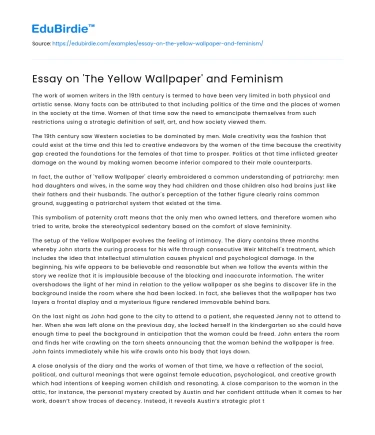Introduction
Charlotte Perkins Gilman's short story, The Yellow Wallpaper, published in 1892, serves as a compelling critique of the patriarchal structures that governed women's lives during the late nineteenth century. The narrative, written in the form of a personal journal, details the descent into madness of a woman confined by her husband in an effort to cure her supposed hysteria. This story is not only an exploration of mental illness but also a powerful feminist text that highlights the oppressive nature of gender roles and the silencing of women's voices. By using the symbol of the wallpaper and the setting of a domestic prison, Gilman effectively critiques the societal norms that restricted women's autonomy. This essay will explore how Gilman's narrative addresses feminist themes, the historical context of women's rights during the time, and counter-arguments that suggest an alternative interpretation, ultimately reaffirming the text's significance in feminist literature.
The Symbolism of the Wallpaper
The yellow wallpaper becomes a central symbol in Gilman's story, representing the societal constraints placed upon women. As the protagonist interacts with the wallpaper, it becomes a reflection of her own mental entrapment and struggle for freedom. The intricate patterns of the wallpaper are described as confusing and oppressive, much like the societal expectations that confine women to domestic roles. As the protagonist's obsession with the wallpaper grows, it symbolizes her growing awareness of her own subjugation. According to scholar Susan S. Lanser, the wallpaper serves as "a text designed to be patriarchally unreadable," highlighting the inaccessibility of women's experiences to male understanding (The Feminist Press). This metaphor extends beyond literature, reflecting the real-world struggles faced by women who sought autonomy in a male-dominated society.
Save your time!
We can take care of your essay
- Proper editing and formatting
- Free revision, title page, and bibliography
- Flexible prices and money-back guarantee
The protagonist's eventual breakdown and identification with the figure trapped behind the wallpaper mirrors the real-life cases of women diagnosed with hysteria in the nineteenth century. These women were often subjected to the "rest cure," a treatment that enforced isolation and inactivity, as prescribed by the male-dominated medical field. Gilman's own experience with this treatment, prescribed by Dr. S. Weir Mitchell, informed her depiction of the protagonist's plight. The story, therefore, acts as a critique of the medical practices of the time and a plea for greater understanding and autonomy for women. By using the wallpaper as a symbol, Gilman illustrates the need for societal change and the liberation of women's voices.
Historical Context and Feminist Critique
During the late nineteenth century, women were largely confined to the private sphere, expected to fulfill roles as wives and mothers. The doctrine of separate spheres dictated that men were to engage in public life, while women remained in the domestic realm. This division reinforced a power imbalance that denied women autonomy and agency. Gilman's The Yellow Wallpaper challenges this ideology by illustrating the detrimental effects of such confinement. The protagonist's mental deterioration serves as an allegory for the consequences of denying women the freedom to engage intellectually and creatively.
Gilman's critique aligns with the burgeoning feminist movement of her time, which sought to dismantle the social structures that oppressed women. By highlighting the protagonist's forced submission and lack of control over her own life, Gilman underscores the feminist argument for women's emancipation and equality. As scholar Elaine Hedges notes, "Gilman's story is a devastating critique of the position of women within the institution of marriage" (Feminist Studies). The story's enduring relevance speaks to the continued struggle for gender equality, as contemporary feminists draw parallels between the historical context of the story and ongoing issues of women's rights.
Counter-Arguments and Alternative Interpretations
While The Yellow Wallpaper is widely regarded as a feminist text, some critics offer alternative interpretations that focus on the story's psychological and horror elements. These interpretations suggest that the narrative can be read as a depiction of mental illness rather than solely a feminist critique. The story's descent into madness and the protagonist's unreliable narration invite readers to consider the psychological aspects of the tale. Critics like Greg Johnson argue that the story's horror elements can be appreciated independently of its feminist themes (American Literature).
However, even within these alternative readings, the feminist themes remain relevant. The protagonist's mental condition can be seen as a product of the oppressive environment she inhabits, reinforcing the story's critique of gender roles. The psychological horror is intertwined with the feminist message, as the protagonist's mental unraveling is directly linked to her lack of autonomy and the societal expectations placed upon her. Thus, while different interpretations exist, they often serve to highlight, rather than detract from, the story's feminist undertones.
Conclusion
The Yellow Wallpaper remains a seminal work in feminist literature, offering a poignant critique of the societal norms that constrained women in the nineteenth century. Through the use of symbolism, historical context, and a compelling narrative, Gilman exposes the oppressive structures that denied women their autonomy and agency. While alternative interpretations exist, the story's feminist themes continue to resonate, underscoring the ongoing struggle for gender equality. As a reflection of both its time and timeless issues, Gilman's work serves as a reminder of the importance of women's voices and the need for continued advocacy for women's rights. Ultimately, The Yellow Wallpaper challenges readers to reconsider the societal structures that impact women's lives, making it an enduring piece of feminist literature.






 Stuck on your essay?
Stuck on your essay?

